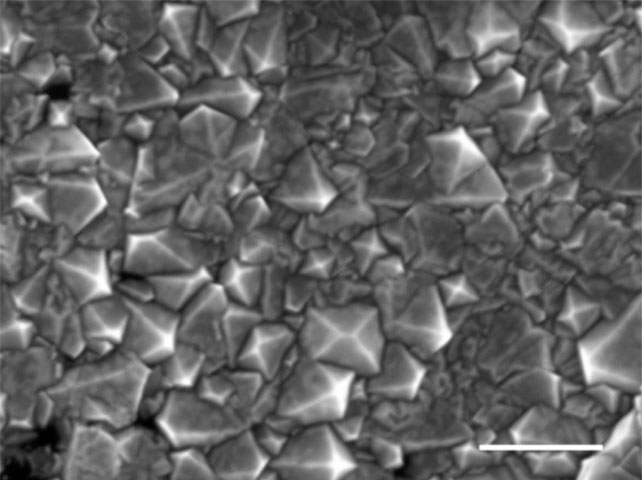Scientists Develop Process for Producing Synthetic Diamonds Using Liquid Metals at Approximately 1,000 Degrees Celsius and Low Pressure.
Natural diamonds take billions of years to form under extreme pressure and temperature deep within the Earth. Synthetic diamonds can be produced much faster, but they often still require intense pressure for several weeks. However, the new method based on a mixture of liquid metals can create diamonds in just 150 minutes at a temperature of 1,025 degrees Celsius without the need for enormous pressure.

Scanning electron microscope image of a diamond film formed by liquid metals. (Photo: Nature).
The new research was conducted by a team of scientists at the Korea Institute of Basic Science and published in the journal Nature on April 24. They believe that this method could be scaled up to make a significant difference in the field of synthetic diamond production.
Dissolving carbon into liquid metals to produce diamonds is not entirely new. For instance, General Electric developed such a process about half a century ago using molten iron sulfide. However, the process still required a pressure of 5-6 gigapascals and a “seed” diamond for the carbon to adhere to.
“We have discovered a method to develop diamonds at a pressure of 1 atm (atmospheric pressure at sea level) and moderate temperature using a mixture of liquid metals,” the research team wrote in their new study.
They successfully reduced the pressure requirement by carefully mixing the liquid metals gallium, iron, nickel, and silicon. A specialized vacuum system was created within the graphite shell to quickly heat and cool the metal while it was in contact with a mixture of methane and hydrogen.
These conditions allowed carbon atoms from the methane to infiltrate the molten metal, acting as “seeds” for the diamond. After 15 minutes, small crystalline diamond fragments began to emerge just beneath the surface of the liquid metal. After 150 minutes, a continuous diamond film was formed.
Although the concentration of carbon that produced the crystals decreased at depths of only a few hundred nanometers, the research team hopes the process can be improved with some adjustments. These adjustments will take time, and the research is still in its early stages, but they believe the new method has great potential and could incorporate other liquid metals to achieve similar, if not better, results.




















































